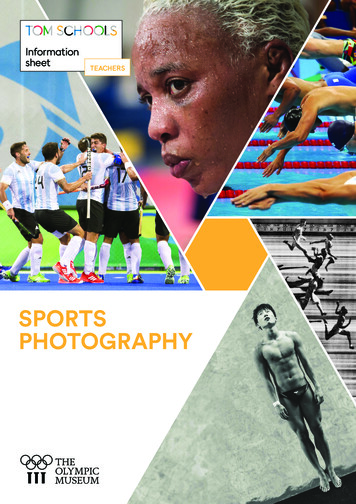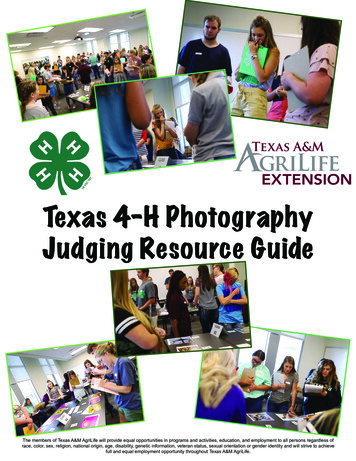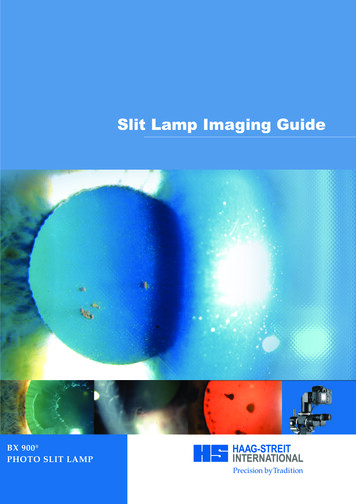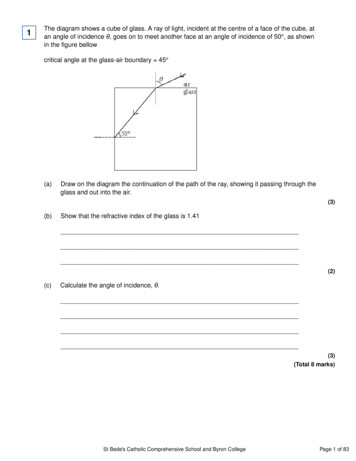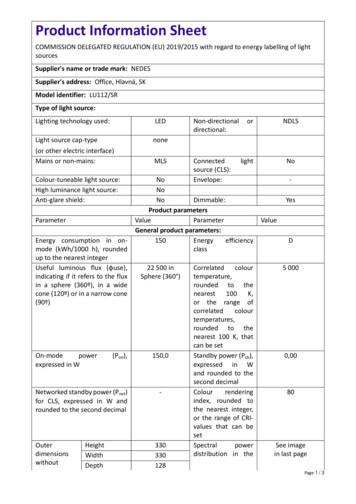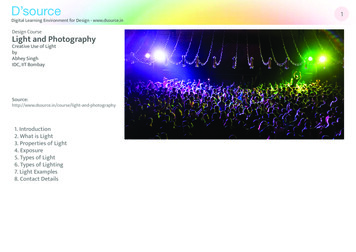
Transcription
D’sourceDigital Learning Environment for Design - www.dsource.inDesign CourseLight and PhotographyCreative Use of LightbyAbhey SinghIDC, IIT d-photography1. Introduction2. What is Light3. Properties of Light4. Exposure5. Types of Light6. Types of Lighting7. Light Examples8. Contact Details1
D’source2Digital Learning Environment for Design - www.dsource.inDesign CourseIntroductionCreative Use of LightbyAbhey SinghIDC, IIT BombayWhat to Expect?This course contains information which will help you to start knowing about the creative use of light in photography. In broad terms this course is divided in 2 parts. First part will be about knowing light. It contains informationabout basic character of light. The second part is about the practical applications of light in photography. Herewe will introduce concepts which are defined over the time to use light in a effective manner.Light and PhotographyKnowing LightWe will start by looking light in scientific terms and then see how it contributes in seeing things. After that wewill move to the properties of light which are important to ght-and-photography/introduction1. Introduction2. What is Light3. Properties of Light4. Exposure5. Types of Light6. Types of Lighting7. Light Examples8. Contact DetailsPractical Applications in PhotographyThis part will start from learning about exposure. A photograph is formed when light hit a recording surface (filmor digital sensor). Exposure is basically determining how much light is the right choice for recording the image.After learning about the exposure we will move to the basics of lighting.
D’source3Digital Learning Environment for Design - www.dsource.inDesign CourseWhat is LightCreative Use of LightbyAbhey SinghIDC, IIT BombayA. Scientific DefinitionLight and PhotographyTechnically speaking light (more specifically visible light) is part of electromagnetic wave spectrum. It is usuallyrefers as visible light which is visible to human eye and responsible for the sense of sight. ( source: Wikipedia)Well this is the most simple scientific definition of light but if you are still confused about some terms, don’t worry, next we will be going to discuss the role of light in ght-and-photography/what-light1. Introduction2. What is Light3. Properties of Light4. Exposure5. Types of Light6. Types of Lighting7. Light Examples8. Contact Details
D’source4Digital Learning Environment for Design - www.dsource.inDesign CourseLight and PhotographyCreative Use of LightbyAbhey SinghIDC, IIT d-photography/what-light1. Introduction2. What is Light3. Properties of Light4. Exposure5. Types of Light6. Types of Lighting7. Light Examples8. Contact DetailsB. Light in PhotographyCamera Obscura and How an Image is FormedCamera Obscura was the first camera ever invented. It is a large dark room with a small opening and forms ainverted image on the wall. In modern times the small hole of the camera Obscura is replaced by a lens and thewall by a sensor.Light in Photography are What the Colours are in PaintingIn painting there is a canvas (a material where the image will be reproduced), colours (the medium for creatingimage) and a brush ( a tool which is used to apply colours on canvas). In photography you can say that:Colours Light (raw material)Brush Lens (handles the raw material)Canvas Sensor/Film (Physical reproduction medium)
D’source5Digital Learning Environment for Design - www.dsource.inDesign CourseLight and PhotographyCreative Use of LightbyAbhey SinghIDC, IIT d-photography/properties-light1. Introduction2. What is Light3. Properties of Light4. Exposure5. Types of Light6. Types of Lighting7. Light Examples8. Contact DetailsProperties of Light
D’source6Digital Learning Environment for Design - www.dsource.inDesign CourseA. Reflection/ Refraction/ AbsorptionCreative Use of LightbyAbhey SinghIDC, IIT BombayWhen Light StrikesThe colour of the objects we see in the natural world is the result of the way objects interact with light. Whena light strikes an object, it can be absorbed, reflected, or transmitted by the object. All objects have a degree ofreflection and absorption. It is due to selective reflection and sometimes due to transmission that gives colour todifferent surfaces.Source:All three of the properties have different use in photography industry. Reflection amounts to the ambient natureof natural light. Sun is the only major source in nature but most surfaces reflect light that comes from sun actingas pseudo-sources. It is also used in making reflectors, is the basis of how we see colours and used in bounce offflash. Transmission is the basis of making equipments like diffusers, filters and gels. Absorption is mainly used toblock light for subtractive lighting.Light and photography/properties-light1. Introduction2. What is Light3. Properties of Light4. Exposure5. Types of Light6. Types of Lighting7. Light Examples8. Contact DetailsIn natural world, light can also be transmitted by an object with no effect (example: X-rays) however they have novisual effect so no worries.
D’source7Digital Learning Environment for Design - www.dsource.inDesign CourseLight and PhotographyCreative Use of LightbyAbhey SinghIDC, IIT BombayReflectionReflection most common and most used property of light. One of the most common use is when flash light isbounced off the ceiling or a wall to obtain a diffused soft light on the subject. For photography purposes we canclassify it into two broad categories: regular reflection and diffuse reflection.Reflection on a SmoothSurface (mirror)Light bounces off the surface of a material at an angle equal to the angle of incoming light wave. Example : mirror or glass.Scatter or Diffuse Reflection (reflection on a rough surface)Light waves bounce off at many angles because the surface is uneven. Example : earth (that is why sky is d-photography/properties-light1. Introduction2. What is Light3. Properties of Light4. Exposure5. Types of Light6. Types of Lighting7. Light Examples8. Contact Details
D’source8Digital Learning Environment for Design - www.dsource.inDesign CourseLight and PhotographyCreative Use of LightbyAbhey SinghIDC, IIT d-photography/properties-light1. Introduction2. What is Light3. Properties of Light4. Exposure5. Types of Light6. Types of Lighting7. Light Examples8. Contact DetailsAbsorptionLight stops at the object and does not reflect or refract. Objects appear dark or opaque. The energy thus absorbed manifests as heat. Absorption is useful in subtractive lighting techniques. Example : Wood
D’source9Digital Learning Environment for Design - www.dsource.inDesign CourseLight and PhotographyCreative Use of LightbyAbhey SinghIDC, IIT d-photography/properties-light1. Introduction2. What is Light3. Properties of Light4. Exposure5. Types of Light6. Types of Lighting7. Light Examples8. Contact DetailsTransmissionTransmission is when light passes through the surface. Filters or gels work on selective transmission.Direct TransmissionWhen light goes through an object and no change in direction or quality takes place. For example - glass or airDiffuse TransmissionWhen light goes through a transparent or semi-transparent object with texture. Example : frosted glassLight will be softer, less contrast, less intensity.Selective TransmissionWhen light goes through a coloured object. A portion will be absorbed and another portion will be transmittedthrough this object.
D’sourceDigital Learning Environment for Design - www.dsource.inDesign CourseLight and PhotographyCreative Use of LightbyAbhey SinghIDC, IIT d-photography/properties-light1. Introduction2. What is Light3. Properties of Light4. Exposure5. Types of Light6. Types of Lighting7. Light Examples8. Contact Details10RefractionLight goes through the object and bends at an angle. Example : diamond (greater angle) or water (lesser angle).
D’sourceDigital Learning Environment for Design - www.dsource.inDesign CourseLight and PhotographyCreative Use of LightbyAbhey SinghIDC, IIT d-photography/properties-light1. Introduction2. What is Light3. Properties of Light4. Exposure5. Types of Light6. Types of Lighting7. Light Examples8. Contact Details11B. Inverse Square LawIntensity of a point source of light is inversely proportional to the square of the distance. In simple terms if wedouble the distance, the intensity of light drops to 1/4th. The effect of this law is not particularly visible in sunlight but it is very apparent while using artificial lights especially in studio. Generally speaking it means that lightfalls off drastically with distance. So while using flash and other artificial sources, distance matters a lot.
D’sourceDigital Learning Environment for Design - www.dsource.inDesign CourseLight and PhotographyCreative Use of LightbyAbhey SinghIDC, IIT d-photography/properties-light1. Introduction2. What is Light3. Properties of Light4. Exposure5. Types of Light6. Types of Lighting7. Light Examples8. Contact Details12C. Color TemperatureThe temperature at which a black body would emit radiation of the same colour as a given object. In simple language, colour temperature is the colour of the light. It depends on the source of the light that is producing it.
D’sourceDigital Learning Environment for Design - www.dsource.inDesign CourseLight and PhotographyCreative Use of LightbyAbhey SinghIDC, IIT d-photography/properties-light1. Introduction2. What is Light3. Properties of Light4. Exposure5. Types of Light6. Types of Lighting7. Light Examples8. Contact Details13
D’sourceDigital Learning Environment for Design - www.dsource.inDesign CourseLight and PhotographyCreative Use of LightbyAbhey SinghIDC, IIT d-photography/properties-light1. Introduction2. What is Light3. Properties of Light4. Exposure5. Types of Light6. Types of Lighting7. Light Examples8. Contact Details14White BalanceWhen the source of light is not completely white, the whites in the image comes out tinted. For example, a whitepaper will look yellow in a yellow tungsten light. White balance is adjusting the setting in the camera to compensate for the coloured light. So as the name suggests it is adjusting to get the right white.In most of the cameras there are in-built presets for different type of common lights like tungsten, flash, shade,daylight etc. Sunlight is neutral with a temperature of around 5500K, the temperatures below it contains warmtones (red, orange, yellow) and the temperatures above 5500K belongs to cool tones (blue, magenta).
D’sourceDigital Learning Environment for Design - www.dsource.in15Design CourseLight and PhotographyCreative Use of LightbyAbhey SinghIDC, IIT d-photography/properties-light1. Introduction2. What is Light3. Properties of Light4. Exposure5. Types of Light6. Types of Lighting7. Light Examples8. Contact DetailsD. ColourLight consists of seven different colours. When all the different wavelengths belonging to different colours combine, it produces white light. Colour as we see in universe is the result of selective reflection and selective transmission of light. It is in principle effect of the light waves that come from the object to our eyes. These wavescan be the result of reflection, transmission or maybe the object is the light source. So that is it we see colours inobject due to the light waves coming from them.
D’source16Digital Learning Environment for Design - www.dsource.inDesign CourseLight and PhotographyCreative Use of LightbyAbhey SinghIDC, IIT d-photography/properties-light1. Introduction2. What is Light3. Properties of Light4. Exposure5. Types of Light6. Types of Lighting7. Light Examples8. Contact DetailsE. Quality of LightRelative size of the light source with respect to subject renders the light source as hard/soft. Hard light has morecontrast, accentuate the texture and gives a more decisive feel in the photograph. Soft light in turn has less contrast, it makes the surface look smooth and gives a more moderate feel. In a way you can see hard light as black/white and soft light as the mid-tones between the extreme blacks and whites of hard light. Diffused light is softlight as light scatters and effective size of light source increases.Soft Light Create soft shadows. Difficult to control as it is not that focused and light spills in all directions. Presents form through a range of tones.Hard Light Create harsh shadows. Accentuate textures. Easy to control and shape as it can be easily directed.
D’source17Digital Learning Environment for Design - www.dsource.inDesign CourseLight and PhotographyCreative Use of LightbyAbhey SinghIDC, IIT d-photography/properties-light1. Introduction2. What is Light3. Properties of Light4. Exposure5. Types of Light6. Types of Lighting7. Light Examples8. Contact DetailsF. Natural Light and Artificial LightAlthough the characteristics of light as an electromagnetic wave don’t change whatever the source, for practical purposes in photography we make the distinction of natural/artificial light. In general terms the light fromsources not made by mankind is termed as natural light and light from sources which are constructed by humanbeings is termed as artificial light.Two most visible differences between natural and artificial light are:1. The nature of fill2. The rapid fall-off in intensityIn natural light sun is the only source but it bounces off from so many surfaces resulting in a wrap-around lighting. So sunlight behaves more like a Omni-directional light as compared toartificial light Which is much directional. Due to inverse square law all light should fall with distance but due tothe distance of sun and earth, any small increment we do on earth is negligible.G. PolarisationLight exhibit the behavior of both a particle and a wave. As a wave phenomenon a light wave can have vibratingwaves in all directions, horizontal, vertical and in between. When reflected from a flat surface like water, most ofthe light aligns in one particular plane. This is known as polarised light. Polarisation property is used in makingpolarising filters which cancels light coming from a particular direction. It reduces glares coming from flat surfaces, thus making colours like blue in sky more dominant.
D’source18Digital Learning Environment for Design - www.dsource.inDesign CourseLight and PhotographyCreative Use of LightbyAbhey SinghIDC, IIT d-photography/exposure1. Introduction2. What is Light3. Properties of Light4. Exposure5. Types of Light6. Types of Lighting7. Light Examples8. Contact DetailsExposure
D’source19Digital Learning Environment for Design - www.dsource.inDesign CourseLight and PhotographyCreative Use of LightbyAbhey SinghIDC, IIT d-photography/exposure1. Introduction2. What is Light3. Properties of Light4. Exposure5. Types of Light6. Types of Lighting7. Light Examples8. Contact DetailsA. ApertureApertureThe opening of the lens which controls the amount of light entering the camera.
D’source20Digital Learning Environment for Design - www.dsource.inDesign CourseLight and PhotographyCreative Use of LightbyAbhey SinghIDC, IIT d-photography/exposure1. Introduction2. What is Light3. Properties of Light4. Exposure5. Types of Light6. Types of Lighting7. Light Examples8. Contact DetailsF-Number, F-stop, Focal Ratio, Relative ApertureQuantitative unit used to measure the opening of aperture. Changing the f-number means changing the aperture. F-number is commonly notated using a hooked f i.e. f/N where N is the f-Number. As denoted in the formulafor f-number, it has a inverse relation with aperture opening. A low f-number means larger opening and morelight.N f/Df focal lengthD diameter of diaphragmStopStops are units used to quantify exposure. Changing one stop means doubling or halving the exposure. It is alsoknown as exposure value (EV).F-stopF-stops are exposure values of aperture. Changing aperture by one f-stop means doubling or halving the light bydoubling or halving the aperture opening.
D’source21Digital Learning Environment for Design - www.dsource.inDesign CourseLight and PhotographyCreative Use of LightbyAbhey SinghIDC, IIT d-photography/exposure1. Introduction2. What is Light3. Properties of Light4. Exposure5. Types of Light6. Types of Lighting7. Light Examples8. Contact DetailsDepth of FieldThe distance between the nearest and the farthest point in a scene that is recorded completely in focus.
D’sourceDigital Learning Environment for Design - www.dsource.inDesign CourseLight and PhotographyCreative Use of LightbyAbhey SinghIDC, IIT d-photography/exposure1. Introduction2. What is Light3. Properties of Light4. Exposure5. Types of Light6. Types of Lighting7. Light Examples8. Contact Details22B. Shutter SpeedWhen you press camera shutter button, what happens is camera shutter opens up to allow light to hit the camera sensor. Shutter speed denotes the amount of time the camera shutter remains open when a photographis clicked. Although it is named as speed, it is basically a measurement of time. To avoid the confusion of howaperture is measured in f-numbers and shutter speed in time, all the increment changes in aperture and shutterspeed are denoted as stops.
D’sourceDigital Learning Environment for Design - www.dsource.inDesign CourseLight and PhotographyCreative Use of LightbyAbhey SinghIDC, IIT d-photography/exposure1. Introduction2. What is Light3. Properties of Light4. Exposure5. Types of Light6. Types of Lighting7. Light Examples8. Contact Details23
D’source24Digital Learning Environment for Design - www.dsource.inDesign CourseLight and PhotographyCreative Use of LightbyAbhey SinghIDC, IIT BombayReciprocal RelationshipShutter speed and aperture shares inverse relation when it comes to exposure. If we increase aperture by onestop, we have to decrease shutter speed by one stop to maintain same exposure.Increase by one stop of aperture Double the exposure Reducing f-number by one stop.Increase by one stop of shutter speed Double the exposure Increasing the exposure time by one stop.C. ISOA measure of the sensitivity of the sensor/film. High ISO means more sensitive sensor/film and less amount oflight is needed to make the -and-photography/exposure1. Introduction2. What is Light3. Properties of Light4. Exposure5. Types of Light6. Types of Lighting7. Light Examples8. Contact DetailsNoisePresence of grains creating a speckled effect, most of the times due to high ISO.
D’sourceDigital Learning Environment for Design - www.dsource.inDesign CourseLight and PhotographyCreative Use of LightbyAbhey SinghIDC, IIT d-photography/exposure1. Introduction2. What is Light3. Properties of Light4. Exposure5. Types of Light6. Types of Lighting7. Light Examples8. Contact Details25D. MeteringA photograph is made of light exposing a imagery on a surface. One of the basic factor in obtaining a good imageis deciding the right amount of light required to make the image. Over the time various methods and instruments have been invented to determine the correct exposure.
D’source26Digital Learning Environment for Design - www.dsource.inDesign CourseLight and PhotographyCreative Use of LightbyAbhey SinghIDC, IIT BombayMeteringIn photography metering refers to the mechanism a camera adopts to determine what would be the rightamount of light for the particular scene.Values/ Tones/ Dynamic RangeValues are basically various levels of greys. If we follow Ansal Adams model, there are 11 different groups of greys,ranging from 100 % black to 100% white.18% Grey18% grey is the grey tone which reflect 18% of the light. It is considered as the average of the entire tonal range.All the modern meters are based on assuming 18% grey as the average -photography/exposure1. Introduction2. What is Light3. Properties of Light4. Exposure5. Types of Light6. Types of Lighting7. Light Examples8. Contact DetailsIncident Light MeterIt meters the light falling on the subject to determine the correct exposure. It is set according to the 18% greyreflectance irrespective of the subject.Reflected Light MeterIt meters the light reflected from the subject to determine the right exposure for a image. Most of the DSLRsuse this to determine the exposure. It works good in diversity of tones. It doesn’t work that good when there areextreme tones or tones which belongs majorly to one extreme.TTL Reflected Light MeteringIt meters all the tones in the image and adjusts the exposure to bring the average to 18% grey. There are variousways for the camera to evaluate the scene and calculate the average.Evaluative MeteringIt takes into account all the pixels of the image and average them out to determine the exposure.Centre-Weighed AverageIt gives more weightage to the parts near the centre of the image in calculating the average.Partial MeteringIt takes into account a circle with centre at the mid of frame.Spot-MeteringIt only analyses the pixels around the centre to determine the exposure.
D’sourceDigital Learning Environment for Design - www.dsource.inDesign CourseLight and PhotographyCreative Use of LightbyAbhey SinghIDC, IIT d-photography/exposure1. Introduction2. What is Light3. Properties of Light4. Exposure5. Types of Light6. Types of Lighting7. Light Examples8. Contact Details27
D’sourceDigital Learning Environment for Design - www.dsource.inDesign CourseLight and PhotographyCreative Use of LightbyAbhey SinghIDC, IIT d-photography/exposure1. Introduction2. What is Light3. Properties of Light4. Exposure5. Types of Light6. Types of Lighting7. Light Examples8. Contact Details28E. HistogramIt is the graph of various values of grey versus number of pixels. It shows the distribution of various grey valueswith respect to the number of pixels with that grey value.
D’sourceDigital Learning Environment for Design - www.dsource.inDesign CourseLight and PhotographyCreative Use of LightbyAbhey SinghIDC, IIT d-photography/exposure1. Introduction2. What is Light3. Properties of Light4. Exposure5. Types of Light6. Types of Lighting7. Light Examples8. Contact Details29Highlights/ Shadows/ Mid-tonesThe dynamic range of the camera is commonly divided in three segments. Highlights are the white areas, shadows are the dark areas and mid-tones are the grays in between.
D’sourceDigital Learning Environment for Design - www.dsource.inDesign CourseLight and PhotographyCreative Use of LightbyAbhey SinghIDC, IIT d-photography/exposure1. Introduction2. What is Light3. Properties of Light4. Exposure5. Types of Light6. Types of Lighting7. Light Examples8. Contact Details30F. Exposure CompensationTechnique for adjusting exposure indicated by exposure meter. It is used in conditions when meters are unable togive right reading or we consciously want a underexposed or over exposed image.
D’source31Digital Learning Environment for Design - www.dsource.inDesign CourseTypes of LightCreative Use of LightbyAbhey SinghIDC, IIT BombayKey/ Fill/ Back lightLight and PhotographyKey LightAs the name suggests this is the most important light. Key light defines the shadows in a composition. All theother lights are placed according to the key light.Fill LightA fill light is used to open up the shadows. Ideally fill light doesn’t have its own shadow as it is generally less inintensity than the key d-photography/types-light1. Introduction2. What is Light3. Properties of Light4. Exposure5. Types of Light6. Types of Lighting7. Light Examples8. Contact DetailsKicker/ Rim/ Accent LightLights that outline the subject and separate the subject from the background. These lights are also known as sidelights or hair light depending on where they are placed. These lights helps in popping the subject out. This lightcontributes to the lightest tones and specular highlights.
D’source32Digital Learning Environment for Design - www.dsource.inDesign CourseLight and PhotographyCreative Use of LightbyAbhey SinghIDC, IIT d-photography/types-light1. Introduction2. What is Light3. Properties of Light4. Exposure5. Types of Light6. Types of Lighting7. Light Examples8. Contact DetailsHow To Set The Light?1. Set The Key LightPosition the key light to define the shadows.2. Add FillAdd fill light depending on how much details you want in the shadows.3. Look For Rim LightsSee if you can have a rim light from side or back which can add further to the image.
D’sourceDigital Learning Environment for Design - www.dsource.inDesign CourseLight and PhotographyCreative Use of LightbyAbhey SinghIDC, IIT d-photography/types-light1. Introduction2. What is Light3. Properties of Light4. Exposure5. Types of Light6. Types of Lighting7. Light Examples8. Contact Details33Lighting RatiosThe ratio between the key light and the fill light. It is calculated as ratio between- Key Fill : Fill. A 2:1 ratio meansflat lighting where both sides of face are lit evenly.
D’source34Digital Learning Environment for Design - www.dsource.inDesign CourseTypes of LightingCreative Use of LightbyAbhey SinghIDC, IIT BombayFront LightingKey light is directly behind the camera giving the subject an even exposure. This kind of lighting is most simpleand easy to meter. In natural light conditions we can see this type of light in first hour after sunrise and last fewhours of daylight.Light and PhotographySide LightingKey light is coming from one side. Front lighting might render a subject 2-dimensional, side lighting gives it a volume and 3-dimensional look. This evokes stronger response from the audience especially when taking t-and-photography/types-lighting1. Introduction2. What is Light3. Properties of Light4. Exposure5. Types of Light6. Types of Lighting7. Light Examples8. Contact DetailsBack LightingKey light is behind the subject. Silhouette pictures are best examples of this kind of lighting. By adding fill light itcan be used beautifully for portraits where back-light acts like a rim light.
D’sourceDigital Learning Environment for Design - www.dsource.inDesign CourseLight and PhotographyCreative Use of LightbyAbhey SinghIDC, IIT d-photography/types-lighting1. Introduction2. What is Light3. Properties of Light4. Exposure5. Types of Light6. Types of Lighting7. Light Examples8. Contact Details35
D’source36Digital Learning Environment for Design - www.dsource.inDesign CourseLight and PhotographyLight ExamplesCreative Use of LightbyAbhey SinghIDC, IIT d-photography/light-examples1. Introduction2. What is Light3. Properties of Light4. Exposure5. Types of Light6. Types of Lighting7. Light Examples8. Contact DetailsMorning one source light working as backlight.
D’source37Digital Learning Environment for Design - www.dsource.inDesign CourseLight and PhotographyCreative Use of LightbyAbhey SinghIDC, IIT d-photography/light-examples1. Introduction2. What is Light3. Properties of Light4. Exposure5. Types of Light6. Types of Lighting7. Light Examples8. Contact DetailsTwo big light sources from above give this rim light around the head.
D’source38Digital Learning Environment for Design - www.dsource.inDesign CourseLight and PhotographyCreative Use of LightbyAbhey SinghIDC, IIT d-photography/light-examples1. Introduction2. What is Light3. Properties of Light4. Exposure5. Types of Light6. Types of Lighting7. Light Examples8. Contact DetailsBacklight creating a rim light around the body.
D’source39Digital Learning Environment for Design - www.dsource.inDesign CourseLight and PhotographyCreative Use of LightbyAbhey SinghIDC, IIT d-photography/light-examples1. Introduction2. What is Light3. Properties of Light4. Exposure5. Types of Light6. Types of Lighting7. Light Examples8. Contact DetailsLight patterns created from trees.
D’source40Digital Learning Environment for Design - www.dsource.inDesign CourseLight and PhotographyCreative Use of LightbyAbhey SinghIDC, IIT d-photography/light-examples1. Introduction2. What is Light3. Properties of Light4. Exposure5. Types of Light6. Types of Lighting7. Light Examples8. Contact DetailsStreet light, giving one-directional hard ligh
Light in Photography are What the Colours are in Painting In painting there is a canvas (a material where the image will be reproduced), colours (the medium for creating image) and a brush ( a tool which is used to apply colours on canvas). In photography you can say that: Colours Lig
